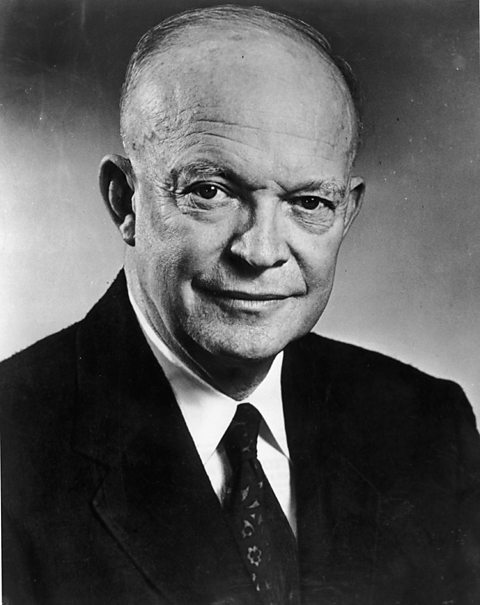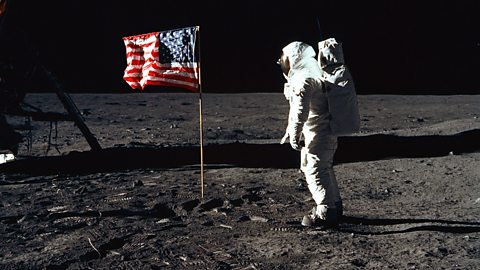The Arms Race and the Space Race

Ever since the USA had dropped the atomic bombA powerful and destructive bomb that gets its power from the energy released when atoms are split. on Hiroshima in 1945, the USSRUnion of Soviet Socialist Republics - collection of states, also known as the Soviet Union. had been determined to develop its own nuclear weapons. It finally succeeded in 1949 and this began a nuclear arms race, with both sides racing to develop more and bigger bombs.
However, it became clear that the superpowerCountries who have huge influence or strength, giving them significant global power. did not intend to use these new weapons hastily. This was demonstrated during the Korean War when President Truman sacked General MacArthur for arguing in favour of using nuclear weapons to end that war.
Nonetheless, a new idea developed: that of nuclear deterrenceThe Cold War theory that nations having nuclear weapons acts as a military strategy as the threat of them makes enemies less likely to attack and more likely to negotiate. . This suggested that the very fact of a country possessing nuclear weapons would prevent another country from threatening its interests, because they wouldnāt want to provoke a nuclear attack. In order to maintain this upper hand, the superpowers had to continue to build up their stockpiles of ever more powerful nuclear weapons so that they would have the power to massively retaliate against any such attack.
As the Cold War developed, the theory of Mutually Assured DestructionSituation that developed due to the nuclear arms race where both America and Russia knew if they started a war it would destroy the world. (MAD) took shape. This said that the existence of such massive nuclear weapons meant that open war between the superpowers, in which nuclear weapons were used, would end life on earth. This was the ultimate deterrent, and both sides continued to build up their arsenals of nuclear weapons to gain this advantage.
There was pressure on the US government from the armed forces and arms manufacturers to increase military spending throughout the 1950s. As President Eisenhower was coming to the end of his term of office, he warned the American public that too much power lay in the hands of this Military-Industrial ComplexThe relationship between a nationās military and the powerful defence industry that supports it, which can be seen to influence wider government military policy.. As an army general, he felt able to resist their pressure, but he was concerned that a future civilianA person who is not on active duty with a military, naval, police, or fire fighting organisation. president wouldnāt be able to resist their arguments for limitless military spending.
This nuclear arms race was also matched by similar competition over space and the race to the moon.
| Date | Major Events of the Arms Race |
| 1945 | USA drops atomic bombs on the Japanese cities of Hiroshima and Nagasaki |
| 1949 | The USSRās first successful atomic bomb test ends American nuclear monopoly |
| 1950 | The UK carries out nuclear tests in Western Australia |
| 1952 | The USA successfully tests the first Hydrogen bomb, 2500 times more powerful than the atomic bomb |
| 1953 | The USSR tests its own Hydrogen bomb. |
| 1955 | The USA publishes its Doctrine of Massive Retaliation stating that any attack on the USA or its allies would be met with incredible destructive force |
| 1957 | In order to launch the satellite Sputnik I, the USSR had developed a rocket. The same rocket was capable of carrying an atomic warhead for thousands of miles. This meant the USSR had created the first Intercontinental Ballistic Missile (ICBM). |
| 1958 | The USA tests its own ICBMs |
| 1959 | The USA deploys Polaris submarines capable of launching nuclear missiles close to the shore of the USSR |
| 1961 | The USSR detonates the Tsar Bomba, a nuclear bomb which produced the largest ever man-made explosion |
| 1962 | The Cuban Missile Crisis ā for 13 days the world stood on the edge of nuclear war |
| 1968 | The USSR develops an Anti-Ballistic Missile system to shoot down in-bound US missiles |
| 1968 | The USA develops MIRV technology - allowing missile warheads to hit multiple targets from one missile |
| Date | 1945 |
|---|---|
| Major Events of the Arms Race | USA drops atomic bombs on the Japanese cities of Hiroshima and Nagasaki |
| Date | 1949 |
|---|---|
| Major Events of the Arms Race | The USSRās first successful atomic bomb test ends American nuclear monopoly |
| Date | 1950 |
|---|---|
| Major Events of the Arms Race | The UK carries out nuclear tests in Western Australia |
| Date | 1952 |
|---|---|
| Major Events of the Arms Race | The USA successfully tests the first Hydrogen bomb, 2500 times more powerful than the atomic bomb |
| Date | 1953 |
|---|---|
| Major Events of the Arms Race | The USSR tests its own Hydrogen bomb. |
| Date | 1955 |
|---|---|
| Major Events of the Arms Race | The USA publishes its Doctrine of Massive Retaliation stating that any attack on the USA or its allies would be met with incredible destructive force |
| Date | 1957 |
|---|---|
| Major Events of the Arms Race | In order to launch the satellite Sputnik I, the USSR had developed a rocket. The same rocket was capable of carrying an atomic warhead for thousands of miles. This meant the USSR had created the first Intercontinental Ballistic Missile (ICBM). |
| Date | 1958 |
|---|---|
| Major Events of the Arms Race | The USA tests its own ICBMs |
| Date | 1959 |
|---|---|
| Major Events of the Arms Race | The USA deploys Polaris submarines capable of launching nuclear missiles close to the shore of the USSR |
| Date | 1961 |
|---|---|
| Major Events of the Arms Race | The USSR detonates the Tsar Bomba, a nuclear bomb which produced the largest ever man-made explosion |
| Date | 1962 |
|---|---|
| Major Events of the Arms Race | The Cuban Missile Crisis ā for 13 days the world stood on the edge of nuclear war |
| Date | 1968 |
|---|---|
| Major Events of the Arms Race | The USSR develops an Anti-Ballistic Missile system to shoot down in-bound US missiles |
| Date | 1968 |
|---|---|
| Major Events of the Arms Race | The USA develops MIRV technology - allowing missile warheads to hit multiple targets from one missile |
| Date | Major events of the Space Race |
| 1957 | The USSR launches Sputnik 1 - the worldās first telecommunications satellite. Sputnik 2 was launched later that year and carried a small dog named Laika ā the first living animal to go into orbit. |
| 1959 | The USSR launches Luna 1 - the first man-made object to orbit the sun. The USA then sent Pioneer 4 to do a fly-past of the Moon, prompting the Soviets to launch Luna 2 at the moon. |
| 1960 | The USA launches Discovery XIV - the first satellite equipped with a spy camera. |
| 1961 | The USSR puts the first man, Yuri Gagarin, into space. The USA responds by launching its own Apollo missions, and Alan Shepard becomes the first American in space. President John F Kennedy challenges America to put a man on the moon by the end of the decade. |
| 1969 | The American astronauts, Neil Armstrong and Buzz Aldrin, become the first men to walk on the moon. |
| Date | 1957 |
|---|---|
| Major events of the Space Race | The USSR launches Sputnik 1 - the worldās first telecommunications satellite. Sputnik 2 was launched later that year and carried a small dog named Laika ā the first living animal to go into orbit. |
| Date | 1959 |
|---|---|
| Major events of the Space Race | The USSR launches Luna 1 - the first man-made object to orbit the sun. The USA then sent Pioneer 4 to do a fly-past of the Moon, prompting the Soviets to launch Luna 2 at the moon. |
| Date | 1960 |
|---|---|
| Major events of the Space Race | The USA launches Discovery XIV - the first satellite equipped with a spy camera. |
| Date | 1961 |
|---|---|
| Major events of the Space Race | The USSR puts the first man, Yuri Gagarin, into space. The USA responds by launching its own Apollo missions, and Alan Shepard becomes the first American in space. President John F Kennedy challenges America to put a man on the moon by the end of the decade. |
| Date | 1969 |
|---|---|
| Major events of the Space Race | The American astronauts, Neil Armstrong and Buzz Aldrin, become the first men to walk on the moon. |

Revision tip
Look at the table below so you understand when the leaders of each superpower changed: